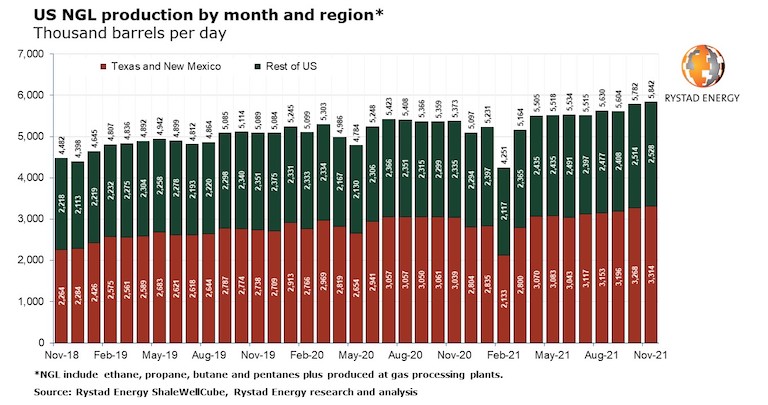Natural gas liquids (NGL) output from processing plants in the US hit a new record high in November 2021, reaching 5.84 million barrels per day (bpd) as a result of a recovery in Gulf of Mexico supplies post-Hurricane Ida and improved ethane processing efficiency, Rystad Energy research indicates. The surge has helped push total US hydrocarbon liquids output to more than 17.3 million bpd, almost back to pre-Covid-19 levels.
The United States’ new record high NGL production in November was about 60,000 bpd higher than the month before and 240,000 bpd more than in September 2021. Texas and New Mexico combined NGL output hit a new all-time high of 3.3 million bpd in November, growing about 10% through the second half of 2021. The rest of the country accounted for the remaining 2.5 million bpd of NGL in November.
As a result of this robust growth, total hydrocarbon liquids production in the US is approaching pre-Covid-19 levels. Liquids output, including crude, lease condensate and NGL, surpassed 17.6 million bpd in November, representing an 8% increase over the year, and approaching the 18 million bpd record set in the first quarter of 2020. Regionally, liquids production in the Permian reached 2.07 million bpd in November, a new record high and 8.5% greater than the first quarter 2020 basin average. However, other major oil regions are still underperforming their pre-pandemic output, lagging their first quarter 2020 average by 13%.
“The Permian is the indisputable driver of US NGL output growth on the back of robust associated gas output and improved ethane recovery while rising crude oil and lease condensate production from the lower 48 states and the Gulf of Mexico have helped total liquids production rebound to near pre-pandemic levels,” says Artem Abramov, head of shale research at Rystad Energy.
Breaking Down the Regions
The Permian Basin renewed its all-time high production level from plants for the fifth month in a row, with total C2-C5+ plant output reaching 2.1 million bpd. Other major oil regions – south Texas’ Eagle Ford, the Bakken, Anadarko and Niobrara – stayed flat compared to October 2021, increasing output by only 1,000 bpd in November. In contrast, output from the major gas regions of Appalachia and Haynesville declined for the fourth month in a row, slipping to around 856,000 bpd total. The total output in these gas regions has steadily declined since August, when total production was 861,000 bpd.

A substantial portion of the nation’s growth in October and November 2021 was driven by Gulf of Mexico supply reactivations and increased ethane recovery in non-core regions. All major basins are in the year-over-year production growth zone, with oil basins growing by more than 300,000 bpd between November 2020 and November 2021, over half of which is from the Permian.
In November, increased ethane (C2) recovery was responsible for a large share of NGL output growth. The output for NGL, excluding ethane (C3+), even declined in most major basins, except for the Permian. In turn, C2 volumes increased across the country, and most basins achieved a record high realized ethane output level. Against that backdrop, the US remains far from the low ethane rejection levels observed late in the first quarter and early in the second quarter of 2021.
For example, realized ethane content in the Permian was recorded at 44% in November compared to the peak of 44.1% in April 2021. The only region which achieved a multi-year record of realized ethane content in October was the Bakken, reaching a staggering 30% in November. For comparison, the Bakken’s ethane content typically stayed close to 20% through 2019-2020. The increase in North Dakota’s ethane recovery is structural and comes on the back of deep cut extraction capacity additions in the first half of 2021.
Fractionation spreads for different NGL components have moved in different directions. A modest degradation in propane fraction spreads was recorded in the last two weeks of October as concerns eased over the country’s general storage levels. In turn, market balance evolved in the opposite direction for butane, pushing C4 fractionation spreads back to the highs touched in September 2021. Ethane fractionation spreads have been gradually trending upwards since November amid robust export levels, making a case for an additional increase in the nation’s ethane recovery in early 2022.

Follow us on social media: